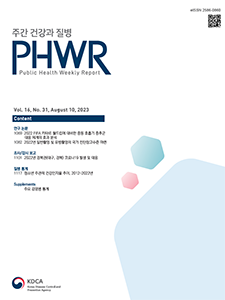Current Issue
Vol.16 No.31, August 10, 2023
-
Original Articles 2023-08-10
 0
0
 545
545
 158
158
Analysis of the Effectiveness of the Middle East Respiratory Syndrome Response System in Preparation for the FIFA World Cup Qatar 2022
Euncheol Son, JiWoo Sim, Yoojin Park, Gasil Hong, In Sil Huh, Hwi-Won Lee
Public Health Weekly Report 2023; 16(31): 1069-1081 https://doi.org/10.56786/PHWR.2023.16.31.1 Abstract
AbstractMiddle East Respiratory Syndrome (MERS) is a respiratory disease with a 36% case fatality rate. More than 2,600 cases have occurred since its first report in 2012, with most patients having been identified in Saudi Arabia and other Middle Eastern countries. We anticipated a surge in number of visitors to the Middle East around December 2022 for the FIFA World Cup Qatar 2022. Accordingly, the Seoul Metropolitan Government and the Capital Regional Center for Disease Control and Prevention of the Korea Disease Control and Prevention Agency (KDCA) established a system for sharing information obtained during surveillance of suspected MERS cases. We hosted training programs on response protocols in cooperation with 25 public health centers in Seoul. The number of suspected MERS reports was 35 in December 2022, which was more than the total number that was reported during the first 11 months that year. Still, the response time to suspected MERS cases decreased significantly: 30 out of 35 cases were processed within 10 minutes. Moreover, the number of suspected cases required for laboratory testing also surged with the increase in contact with camels in Qatar. In December 2022, six cases were submitted for laboratory diagnosis, which was twice as many cases as other months combined. In preparation for the FIFA World Cup, we responded effectively to suspected MERS cases through training and improved response protocol via collaborative efforts by the Seoul Metropolitan Government, the Capital Regional Center for Disease Control and Prevention of KDCA, and public health centers in Seoul.
-
Original Articles 2023-08-10
 1
1
 868
868
 138
138
Korean Diagnostic Reference Level for General Radiography and Mammography in 2022
YongSu Yoon, HyeMin Park, JongHun Won, SeungKi Song, JongWon Gil, ByeongYoung Lee
Public Health Weekly Report 2023; 16(31): 1082-1100 https://doi.org/10.56786/PHWR.2023.16.31.2 Abstract
AbstractThere are no specific limits on patient dose for medical radiation. However, optimizing patient dosage is crucial, and diagnostic reference levels (DRLs) serve as valuable tools for this purpose. DRLs can be set at the national, regional, or institutional level, and regular revisions are recommended. In the Republic of Korea, the Korea Disease Control and Prevention Agency (KDCA) provides national DRLs. This study aimed to derive updated national DRLs for general radiography and mammography through a nationwide survey conducted in 2022. To derive this, a research method was designed to collect data from diagnostic radiation generator inspection institutions. The research team organized and analyzed these data. Data for DRL derivation were collected from four inspection institutions registered with the KDCA, resulting in a larger dataset compared to previous studies. Particularly, a large amount of data from hospitals and clinics was included to ensure that the derived DRLs reflect the current reality. By maintaining this research method, future nationwide surveys on DRLs are expected to be conducted more easily and with greater diversity.
-
Surveillance Reports 2023-08-10
 0
0
 1092
1092
 264
264
The Outbreak and Response of Coronavirus Disease 2019 in Gyeongbuk Area (Daegu, Gyeongbuk) in 2022
Chungmin Park, Hanul Park, Seong Ju Choi, Yeon Haw Jung, Junsuk Son, Jimin Lee, Hwa Bae, Mina Lim, Youkyoung Kim, Taejong Son
Public Health Weekly Report 2023; 16(31): 1101-1116 https://doi.org/10.56786/PHWR.2023.16.31.3 Abstract
AbstractThis report analyzed the current status of coronavirus disease 2019 (COVID-19) confirmed cases and deaths reported in the Gyeongbuk region during 2022, the current status of COVID-19 outbreaks and actions in infection vulnerable facilities. The purpose of this report is to establish a COVID-19 quarantine policy strategy and provide evidence for the future epidemic of infectious diseases. In 2022, there were 2,557,128 confirmed cases in the Gyeongbuk region and 3,283 deaths. In the total number of confirmed cases and deaths, females accounted for a slightly higher proportion than males. By age, the number of confirmed cases was 40–49 years old (14.3%, 365,357 cases), and the number of deaths was the highest at 80 years of age or older with 2,103 cases (64.1%, fatality rate 2.2%). The incidence rate per 100,000 population was higher in Daegu, but the fatality rate was higher in Gyeongsangbuk-do. Of the deaths, the major underlying diseases were shown circulatory system diseases (63.4%), mental diseases such as dementia/depression (36.6%), and endocrine and metabolic diseases such as diabetes/thyroid diseases (29.6%) from the highest. There were also differences in quarantine policies among the three epidemic periods of the Omicron variant in 2022. As a nationwide epidemic occurred due to the dominance of the Omicron variant, which has higher transmission power than the delta variant, the number of confirmed cases in the Gyeongbuk region also increased significantly. The number of deaths in people aged over 60 also increased, mainly in vulnerable facilities to infection.
-
QuickStats 2023-08-10
 1
1
 682
682
 239
239
Trends in the Perceived Health Status among Adolescents, 2012–2022
Public Health Weekly Report 2023; 16(31): 1117-1118 https://doi.org/10.56786/PHWR.2023.16.31.4

pp. 1433~1461
Most Keyword
?
What is Most Keyword?
- It is the most frequently used keyword in articles in this journal for the past two years.
Most Read
-
Waterborne and Foodborne Disease Outbreaks in the Republic of Korea, 2023
Myung-Jae Hwang, So Yeon Park, Hyungjun Kim, Se Jeong Yang, Sungchan Yang, Jin Seon Yang
Public Health Weekly Report 2025;18: 17-32 https://doi.org/10.56786/PHWR.2025.18.1.2 -
Implementation Plan for the Coronavirus Disease 2019 Vaccination for the 2024–2025 Season: Recommendations of the 6th Expert Committee on Immunization Practices
Hyewook Hwang, Wookeon Lee, Seohyeon Ahn, Young-Sook Choi, Seunghyun Lewis Kwon, Dongwoo Lee, Eun Hwa Choi, SokGoo Lee
Public Health Weekly Report 2025;18: 90-102 https://doi.org/10.56786/PHWR.2025.18.2.3
Editorial Office
+82-43-719-7569





 Full Text
Full Text Cite
Cite


